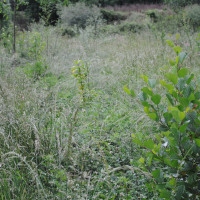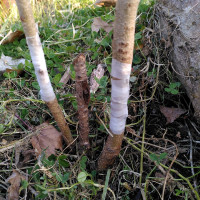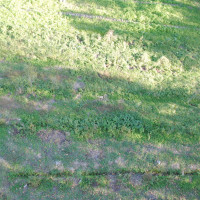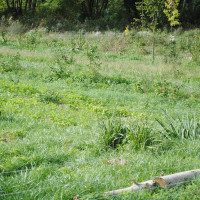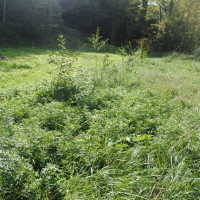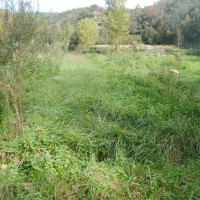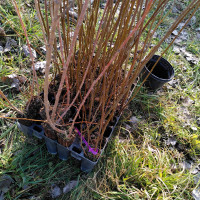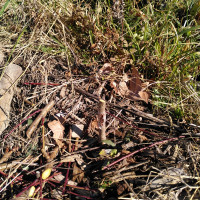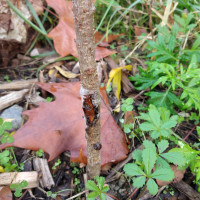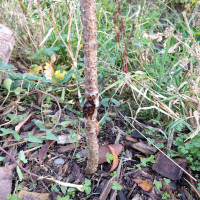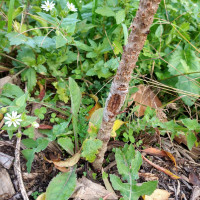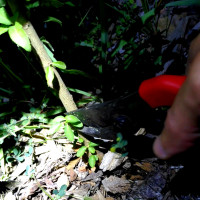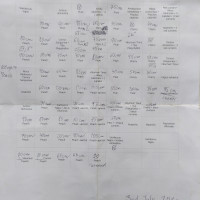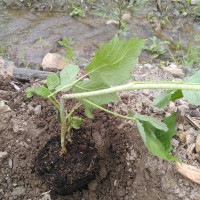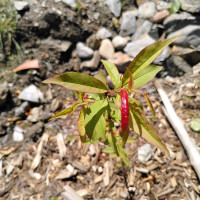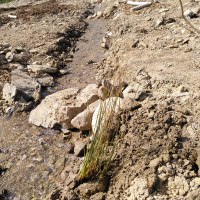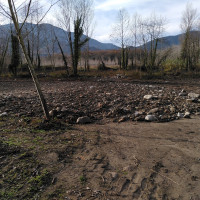Prunus orchard
Peach and plum orchard where Salix atrocinerea will provide a little shade during the hot summer, early nectar for pollinators and biomass.
Alders are planted by every fruit tree to improve soil and are coppiced to grow as a bush to shade-out grasses.
The inter-row cover is a mix of Onobrychis viciifolia, Festuca arundinacea, Dactylitis glomerata and wild flowers. It grows undisturbed from spring onwards to allow reproduction of diverse species. The full inter-row is cut only at end of winter. The margins which are access paths to the fruit trees are cut additionally in May to delay flowering and thus extend the combined flowering period.
Main species
| Species variety | Var | Leafing | Flowering | Fruiting | ||||||||||||||||||||||||||||||||||||
|---|---|---|---|---|---|---|---|---|---|---|---|---|---|---|---|---|---|---|---|---|---|---|---|---|---|---|---|---|---|---|---|---|---|---|---|---|---|---|---|---|
Salix atrocinerea |
|
|
| |||||||||||||||||||||||||||||||||||||
Prunus cerasifera Colló de frare | Colló de frare Fruto oviforme, grande, piel de color amarillo. Pulpa de color amarillo-verdoso que en plena maduración pasa a ser de color amarillo-dorado. Textura firme, jugosa de sabor azucarado muy intenso. Madura en agosto. Árbol común en la zona del Ampurdán. Todavía se encuentran en los márgenes de antiguos cultivos. (Src:Arboreco) |
|
|
| ||||||||||||||||||||||||||||||||||||
Prunus cerasifera San juan | San juan Fruto de calibre pequeño de forma oval-alargada. La piel es verdosa- amarillenta, pulpa verde-amarilla, dulce. Maduración a finales de junio. Típica variedad local (Garrotxa, Cataluña) de ciruelo temprano. (Src:Arboreco) |
|
|
| ||||||||||||||||||||||||||||||||||||
Prunus cerasifera Scagnarda | Scagnarda Fruto mediano, de forma oval más bien alargada. Piel de color amarillo-dorado, pulpa carnosa, medianamente jugosa, se desprende del hueso. Madura a finales de julio. Variedad tradicional difundida hace tiempo en la zona de los Apeninos italianos. Actualmente todavía se encuentra en l'Oltrepò pavese, al oriente de la provincia de Piacenza y en Monferrato. El 1824 el pomólogo Giorgio Gallesio la describió en su “Diario de viaje”, cuando hizo un viaje a Milán. El nombre Scanarda o Scagnarda deriva de una expresión del dialecto de la zona entre l’Oltrepò paveseyi la zona de Piacenza: "da sgagnare" (para morder). Ciruela de Damasco. Árbol de vigor mediano de porte expansivo. Madura a finales de julio. (Src:Arboreco) |
|
|
| ||||||||||||||||||||||||||||||||||||
Prunus persica Amsden | Amsden Fruto entre mediano y grande, piel de color rojo, pulpa blanca, fina, jugosa, dulce. Maduración a principios de julio (Cruïlles). |
|
|
| ||||||||||||||||||||||||||||||||||||
Prunus persica Groc / amarillo | Groc / amarillo Fruto de forma esférica con un surco profundo longitudinal, de tamaño mediano. Piel de color amarillo-blanquecino y amarillo intenso en la parte expuesta al sol, se desprende con dificultad de la pulpa. Pulpa blanca anaranjada, compacta, de sabor dulce, ácido y muy aromático. Maduración principios de julio (Cruïlles – Baix Empordà). Árbol de poco o medio vigor. (Src:Arboreco) |
|
|
| ||||||||||||||||||||||||||||||||||||
Prunus persica Mollar rojo | Mollar rojo El fruto es de forma ovoide redondeada, de tamaño mediano, con piel de color de fondo amarillo-verdoso marmolado de rojo, fina y aromática. La pulpa es de color blanco, rojiza alrededor del hueso, de sabor dulce, muy jugosa y se desprende del hueso, perfumada. Se recoge hacia finales de agosto (Cruïlles – Baix Empordà). Árbol de vigor notable y de altura mediana. (Src:Arboreco) |
|
|
| ||||||||||||||||||||||||||||||||||||
Prunus persica Rouge de roussillon | Rouge de roussillon La forma del fruto es oval con piel aterciopelada, de color calabaza punteada de rojo. Buena calidad gustativa y ligeramente acidulo. Variedad autofértil originaria de la Cataluña Norte. Ideal para hacer mermeladas. Variedad tardía, cosecha entre finales de junio y principios de julio. (Src:Arboreco) |
|
|
| ||||||||||||||||||||||||||||||||||||
Prunus persica Viña | Viña Fruto aproximadamente de 200g. Piel amarilla con una parte roja en la parte expuesta al sol. Pulpa amarilla, firme, dulce, aromática y poco jugosa. Maduración a agosto (Cruïlles – Baix Empordà). Variedad muy resistente a las enfermedades. Melocotón de viña. |
|
|
| ||||||||||||||||||||||||||||||||||||
Alnus glutinosa |
|
|
| |||||||||||||||||||||||||||||||||||||
Rubus idaeus Autumn bliss | Autumn bliss Variedade remontante. A planta es moi vigorosa e produtiva. O froito é grande, sendo a fructificación temperá. (Src:Fragaira) |
|
|
| ||||||||||||||||||||||||||||||||||||
Onobrychis viciifolia |
|
|
|
| Species variety | Tip | Qty | Introduction | Phase-out | Propagation | Medium | Supplier |
|---|---|---|---|---|---|---|---|
Salix atrocinerea | Populus and Salix cutting propogation: Las estacas de Populus y Salix hay que prepararlas cuando no tienen hojas, a sabia parada. Igualmente, el brote que te puedan hacer ahora no estará lignificado y con el frío del invierno se puede quemar. Estas estacas enraizaran y brotaran en primavera, por lo que en invierno poco van a hacer. [Plant supplier / nursery] A pioneer species of willow, it quickly colonizes poor soils. [wikipedia.org] Q__ La estaca de Populus/Salix, tiene que ser del año de crecimiento o puede ser de 2/3 años? Puede ser de 2/3 años. A__ Nosotros lo hacemos en alveolo forestal, por lo que utilizamos estacas delgadas, del año, pero en campo es conveniente ponerlas más gordas para que tengan más reservas y aguanten el terreno. Q__ Y se puede enterrar/clavar la estaca muy profundo, como 40-50cm o más? Se puede pudrir? A__Sí, se puede pudrir, sobretodo si hay agua estancada durante muchos días. Yo intentaría clavarlas en febrero para que estén el menor tiempo enterradas y sin brotar. [Plant supplier / nursery][naturalea.eu] Cuttings directly on the ground need a wide area clearing and weed suppression, use large leaves and heavy thick mulch. [Can Neret] | 37 | 2023-03-18 | Stem cutting | Cutting | Viver Tres Turons | |
Prunus cerasifera Colló de frare | Fruit trees in hot climate benefit from having a little bit of shade. [youtu.be] | 5 | 2021-03-11 | Graft | Bare-root | Arboreco | |
Prunus cerasifera San juan | Fruit trees in hot climate benefit from having a little bit of shade. [youtu.be] | 7 | 2021-03-11 | Graft | Bare-root | Arboreco | |
Prunus cerasifera Scagnarda | Fruit trees in hot climate benefit from having a little bit of shade. [youtu.be] | 7 | 2021-03-11 | Graft | Bare-root | Arboreco | |
Prunus persica Amsden | Fruit trees in hot climate benefit from having a little bit of shade. [youtu.be] Birds find it hard to eat the native peaches. Could it be related to reduced sugar content? | 6 | 2021-03-11 | Graft | Bare-root | Arboreco | |
Prunus persica Groc / amarillo | Fruit trees in hot climate benefit from having a little bit of shade. [youtu.be] Birds find it hard to eat the native peaches. Could it be related to reduced sugar content? | 5 | 2021-03-11 | Graft | Bare-root | Arboreco | |
Prunus persica Mollar rojo | Fruit trees in hot climate benefit from having a little bit of shade. [youtu.be] Birds find it hard to eat the native peaches. Could it be related to reduced sugar content? | 8 | 2021-03-11 | Graft | Bare-root | Arboreco | |
Prunus persica Rouge de roussillon | Fruit trees in hot climate benefit from having a little bit of shade. [youtu.be] Birds find it hard to eat the native peaches. Could it be related to reduced sugar content? | 7 | 2021-03-11 | Graft | Bare-root | Arboreco | |
Prunus persica Viña | Fruit trees in hot climate benefit from having a little bit of shade. [youtu.be] Birds find it hard to eat the native peaches. Could it be related to reduced sugar content? | 6 | 2021-03-11 | Graft | Bare-root | Arboreco | |
Alnus glutinosa | Alders increase the availability of soil phosphorus [researchgate.net] Alders are an important food plant for the caterpillars of many butterfly and moth species and also for small birds in winter.There are 90 insect species associated with this tree. [pfaf.org] "Nitrogen fixation requires rare heavy-metal element molybdenum as a catalyst." ... "To fix 1 gram of nitrogen, an estimated 10-100 grams of glucose is required.' Most microorganisms rarely have energy resources to produce large amounts of fixed nitrogen. Higher plants can produce excess energy through photosynthesis, but they cannot produce the necessary enzyme." [oregonstate.edu] | 37 | 2022-02-16 | Seed | Tray | Viver Tres Turons | |
Rubus idaeus Autumn bliss | Harvest on dry weather, early in the morning and keep cool. [Organic Method Primer] Shrubs benefit from proximity for cross pollination. In shade: taller, thinner, leggier. In sun: denser, smaller [Edible Forest Gardens Vol.2] Blackberries provide shelter for beneficial parasitic wasps, which also kill leaf hopper eggs. [wikipedia.org] | 200 | 2021-05-22 | Root division | Tray | Arboreco | |
Onobrychis viciifolia | Not cut too low because sainfoin tap root tends to rise above ground level and the plant can be killed if this is cut off [pfaf.org] Observe where the pollinators go. "When sainfoin flowers, it is so appealing to honeybees that they will often ignore all other nectar sources to forage on it." p.38 [researchgate.net] Sow sainfoin in September. "One major reason for sainfoin’s poor competitive ability against weeds, compared to lucerne, is its more diffuse canopy structure during the first four months of growth. With this reduced leaf cover, the competition against weeds is disadvantaged. Timely sowing in warm soils can be advantageous as sainfoin grows vigourously in these conditions." p.20 [researchgate.net] "Cutting will delay flowering and it is possible to extend the flowering period for bees by cutting part of the field or margin, so that there is more than on pulse of flowers." p.39 [researchgate.net] | 2021-04-03 | Seed | Seed |
| Species variety | Fnc | Strata | Top | Cut months | Light | Functions | |
|---|---|---|---|---|---|---|---|
Salix atrocinerea | Cut after flowering to provide nectar | Emergent | 10m | Prune [3] | Crop shading, Windbreak | ||
Prunus cerasifera Colló de frare | Canopy | 3m | Prune | ||||
Prunus cerasifera San juan | Canopy | 3m | Prune | ||||
Prunus cerasifera Scagnarda | Canopy | 3m | Prune [2] | ||||
Prunus persica Amsden | Canopy | 3m | Prune | <25% | |||
Prunus persica Groc / amarillo | Canopy | 3m | Prune | <25% | |||
Prunus persica Mollar rojo | Canopy | 3m | Prune | <25% | |||
Prunus persica Rouge de roussillon | Canopy | 3m | Prune | <25% | |||
Prunus persica Viña | Canopy | 3m | Prune | <25% | |||
Alnus glutinosa | Understory | 1m | Coppice [5] | Pioneering, Weed suppression N | |||
Rubus idaeus Autumn bliss | Cut to ground end of winter, on a dry frame. | Understory | 1.5m | Prune [2] | |||
Onobrychis viciifolia | Only cut the pathway providing access to the trees, in April, to delay flowering and extend the area's overall flowering season. | Undergrowth | 1m | Reap/mow [5] | ~50% | Biodiversity N |
Project Log
2024 week 10 17/2°C, 5.5mm
2024 week 09 17/3°C, 33.3mm
2024 week 08 18/3°C, 3.3mm
2024 week 07 20/4°C, 0mm
2024 week 06 18/5°C, 18.5mm
Flowering Viburnum and Prunus
2023 week 40 29/14°C, 0.1mm
2023 week 39 30/13°C, 0mm
2023 week 38 27/14°C, 6.7mm
2023 week 37 30/16°C, 36.8mm
2023 week 36 32/13°C, 0mm
Follow-up
2023 week 20 24/7°C, 0.1mm
2023 week 19 23/10°C, 63.1mm
2023 week 18 26/9°C, 16.1mm
2023 week 17 25/11°C, 10.2mm
2023 week 16 23/6°C, 6.8mm
Species native to Rio Ter. Galanthus nivalis (early flowering), Lamium album (late flowering)
2023 week 19 23/11°C, 55mm
2023 week 18 26/9°C, 16.1mm
2023 week 17 25/11°C, 10.2mm
2023 week 16 23/6°C, 6.8mm
2023 week 15 22/5°C, 0.9mm
Raspberries growing over clover and Onobrychis viciifolia and Cornus sanguinea also flowering
2023 week 16 20/5°C, 2.5mm
2023 week 15 22/5°C, 0.9mm
2023 week 14 20/3°C, 0mm
2023 week 13 21/5°C, 3.6mm
2023 week 12 21/6°C, 0mm
Alder pollarding set-up experiment
2023 week 09 13/-1°C, 0.4mm
2023 week 08 16/4°C, 27.5mm
2023 week 07 18/-0°C, 0.2mm
2023 week 06 11/0°C, 43.4mm
2023 week 05 19/-2°C, 0mm
1) result from fall graft, 2) re-grafting with fresh scions 3) graft status. "N" marks new graft. "check mark" means it looks good.
2023 week 07 17/-1°C, 0.2mm
2023 week 06 11/0°C, 43.4mm
2023 week 05 19/-2°C, 0mm
2023 week 04 10/-4°C, 3.1mm
2023 week 03 12/-1°C, 0.1mm
Visit during calcotada
2022 week 47 15/5°C, 13.4mm
2022 week 46 19/8°C, 13.9mm
2022 week 45 23/8°C, 2.2mm
2022 week 44 23/7°C, 2mm
2022 week 43 26/10°C, 0.1mm
Orchard in the fall
2022 week 46 22/11°C, 0mm
2022 week 45 23/8°C, 2.2mm
2022 week 44 23/7°C, 2mm
2022 week 43 26/10°C, 0.1mm
2022 week 42 27/13°C, 0.1mm
Aerial view
2022 week 43 28/11°C, 0mm
2022 week 42 27/13°C, 0.1mm
2022 week 41 26/12°C, 0.2mm
2022 week 40 24/12°C, 42.7mm
2022 week 39 25/10°C, 13.9mm
Row views from south and north
2022 week 36 31/17°C, 0.1mm
2022 week 35 32/18°C, 14.2mm
2022 week 34 33/19°C, 20.3mm
2022 week 33 31/17°C, 52.2mm
2022 week 32 37/19°C, 18.5mm
Fall re-grafting using scions from year's growth.
2022 week 19 28/11°C, 27mm
2022 week 18 24/10°C, 6.2mm
2022 week 17 23/8°C, 13mm
2022 week 16 19/8°C, 47.8mm
2022 week 15 21/8°C, 5.6mm
Ground cover
2022 week 18 21/10°C, 4.2mm
2022 week 17 23/8°C, 13mm
2022 week 16 19/8°C, 47.8mm
2022 week 15 21/8°C, 5.6mm
2022 week 14 20/4°C, 12.6mm
Flowering apricot. The bud got broken after a light touch.
2022 week 14 16/1°C, 0mm
2022 week 13 15/4°C, 24.4mm
2022 week 12 16/5°C, 15.2mm
2022 week 11 14/9°C, 34.7mm
2022 week 10 14/5°C, 64.1mm
Raspberries and grass
2022 week 07 17/2°C, 1mm
2022 week 06 17/1°C, 0.1mm
2022 week 05 17/1°C, 0mm
2022 week 04 18/-2°C, 0.1mm
2022 week 03 14/-2°C, 0.1mm
Planting Alnus glutinosa 80cm south of every fruit tree to shade grasses and improve soil. Will be coppiced annually.
2022 week 04 18/-2°C, 0.1mm
2022 week 03 14/-2°C, 0.1mm
2022 week 02 14/-2°C, 1.4mm
2022 week 01 15/-0°C, 2.9mm
2022 week 52 14/1°C, 0.4mm
Pruning 2cm above graft point to direct growth to the graft bud.
2021 week 46 17/4°C, 1.3mm
2021 week 45 18/7°C, 31.4mm
2021 week 44 18/3°C, 5.9mm
2021 week 43 22/8°C, 0.4mm
2021 week 42 24/9°C, 0.1mm
Graft follow-up two months later, graft date 2021-09-10. Success rate was about 50%
2021 week 40 22/10°C, 16.3mm
2021 week 39 27/13°C, 0mm
2021 week 38 26/13°C, 30.3mm
2021 week 37 30/17°C, 17.6mm
2021 week 36 29/18°C, 13.7mm
Aerial view
2021 week 36 29/18°C, 13.7mm
2021 week 35 28/16°C, 52.1mm
2021 week 34 30/16°C, 3.6mm
2021 week 33 31/16°C, 0.4mm
2021 week 32 35/18°C, 0mm
Shredding day. All rootstocks were grafted the following day.
2021 week 29 36/19°C, 0mm
2021 week 28 30/15°C, 12.8mm
2021 week 27 31/15°C, 1.3mm
2021 week 26 30/15°C, 0mm
2021 week 25 30/14°C, 0mm
Pruning rootstock growth below future graft point. Working at night to avoid high heat during the day.
2021 week 26 30/15°C, 0mm
2021 week 25 30/14°C, 0mm
2021 week 24 32/17°C, 1.4mm
2021 week 23 32/16°C, 18mm
2021 week 22 27/13°C, 1.2mm
Monitoring tree development.
2021 week 20 24/10°C, 0mm
2021 week 19 23/9°C, 7.4mm
2021 week 18 24/8°C, 0.8mm
2021 week 17 18/10°C, 50mm
2021 week 16 19/5°C, 9.7mm
Raspberry planting
2021 week 19 23/9°C, 7.4mm
2021 week 18 24/8°C, 0.8mm
2021 week 17 18/10°C, 50mm
2021 week 16 19/5°C, 9.7mm
2021 week 15 16/5°C, 3.9mm
All tree nests were inoculated with soil from the forest.
2021 week 18 23/8°C, 0.3mm
2021 week 17 18/10°C, 50mm
2021 week 16 19/5°C, 9.7mm
2021 week 15 16/5°C, 3.9mm
2021 week 14 18/4°C, 19mm
Peach leaf curl on rootstock (non grafted)
2021 week 13 21/2°C, 0mm
2021 week 12 20/3°C, 0mm
2021 week 11 17/1°C, 7.6mm
2021 week 10 16/4°C, 8.2mm
2021 week 09 15/6°C, 7.9mm
Introducing Juncus inflexus for mechanical strength on canal junctions and Typhia latifolia for phytoremediation of still water.
2021 week 11 18/3°C, 0mm
2021 week 10 16/4°C, 8.2mm
2021 week 09 15/6°C, 7.9mm
2021 week 08 18/6°C, 11.6mm
2021 week 07 16/6°C, 3mm
Distributing the water flow evenly for 5 parallel canals
2021 week 10 16/4°C, 8.1mm
2021 week 09 15/6°C, 7.9mm
2021 week 08 18/6°C, 11.6mm
2021 week 07 16/6°C, 3mm
2021 week 06 14/4°C, 13.7mm
Processing biomass
2021 week 09 16/6°C, 5mm
2021 week 08 18/6°C, 11.6mm
2021 week 07 16/6°C, 3mm
2021 week 06 14/4°C, 13.7mm
2021 week 05 18/6°C, 8.5mm
De-compacting top 50cm and creating irrigation canals.
2021 week 08 18/7°C, 11.6mm
2021 week 07 16/6°C, 3mm
2021 week 06 14/4°C, 13.7mm
2021 week 05 18/6°C, 8.5mm
2021 week 04 17/4°C, 2.5mm
Compacted and poorly drained ground
2020 week 52 18/4°C, 0.1mm
2020 week 51 17/5°C, 19.3mm
2020 week 50 14/2°C, 1.2mm
2020 week 49 13/2°C, 0.4mm
2020 week 48 16/5°C, 141.4mm
ACA buried tree trunks and moved heavy machinery on this ground after the "Gloria" hurricane flooding in Jan 2020. Garbage collection took place before vegetation regrowth.
Lessons
-
[Reap/mow] Avoid disrupting birds nesting on grasses. "Desbrozar en invierno mejor. Evitar sobretodo en abril-julio."(Dactylis glomerata ,Festuca arundinacea) - Plant supplier / nursery
[Graft] Buddy tape, seal 2-3 loops also around the bud otherwise insect come, make hole, and the bud dries out -
[Pests] Grasses slow down growth of trees, which means less opportunity for aphids and sucking insects that attack new growth. Grass = shelter for nesting birds(Dactylis glomerata ,Festuca arundinacea) -
[Reap/mow] Not cut too low because sainfoin tap root tends to rise above ground level and the plant can be killed if this is cut off(Onobrychis viciifolia) -
[Plant characteristics] A pioneer species of willow, it quickly colonizes poor soils.(Salix atrocinerea) -
[Design] "Nitrogen fixation requires rare heavy-metal element molybdenum as a catalyst." ... "To fix 1 gram of nitrogen, an estimated 10-100 grams of glucose is required.' Most microorganisms rarely have energy resources to produce large amounts of fixed nitrogen. Higher plants can produce excess energy through photosynthesis, but they cannot produce the necessary enzyme."(Alnus cordata ,Alnus glutinosa) -
[Pollination /Reap/mow] Observe where the pollinators go. "When sainfoin flowers, it is so appealing to honeybees that they will often ignore all other nectar sources to forage on it." p.38(Onobrychis viciifolia) -
[Biodiversity /Reap/mow] "Cutting will delay flowering and it is possible to extend the flowering period for bees by cutting part of the field or margin, so that there is more than on pulse of flowers." p.39(Onobrychis viciifolia)


















